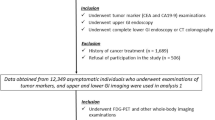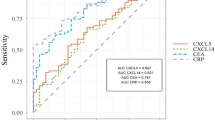Abstract
The serum levels of CA 19-9 and carcinoembryonic antigen (CEA) were determined in 37 patients with benign colorectal diseases and in 111 patients with newly discovered colorectal carcinomas or clinically verified relapses. In cancer patients, the CA 19-9 level ranged from normal (0-37 U ml-1) to 77,500 U ml-1 whereas all samples but one from patients with benign colorectal diseases had a normal value. CA 19-9 was increased in 46% and 45% of patients with an advanced (Dukes C or D) carcinoma or a verified recidive, respectively. Only one out of 26 patients (4%) with a localized (Dukes A or B) carcinoma displayed an elevated CA 19-9 level (greater than 37 U ml-1). No clear correlation was found between the CA 19-9 and CEA levels. The sensitivity of the CA 19-9 test (36%) was poorer than that of the CEA assay (69%), but the new test was markedly more specific (97% vs 70%) than the CEA assay.
This is a preview of subscription content, access via your institution
Access options
Subscribe to this journal
Receive 24 print issues and online access
$259.00 per year
only $10.79 per issue
Buy this article
- Purchase on Springer Link
- Instant access to full article PDF
Prices may be subject to local taxes which are calculated during checkout
Similar content being viewed by others
Rights and permissions
About this article
Cite this article
Kuusela, P., Jalanko, H., Roberts, P. et al. Comparison of CA 19-9 and carcinoembryonic antigen (CEA) levels in the serum of patients with colorectal diseases. Br J Cancer 49, 135–139 (1984). https://doi.org/10.1038/bjc.1984.25
Issue Date:
DOI: https://doi.org/10.1038/bjc.1984.25
This article is cited by
-
Analysis of patients with colorectal cancer shows a specific increase in serum anti-ING1 autoantibody levels
BMC Cancer (2023)
-
FJX1 as a candidate diagnostic and prognostic serum biomarker for colorectal cancer
Clinical and Translational Oncology (2022)
-
Identification of aldolase A as a potential diagnostic biomarker for colorectal cancer based on proteomic analysis using formalin-fixed paraffin-embedded tissue
Tumor Biology (2016)
-
Cytokeratin 7-positive/cytokeratin 20-negative cecal adenocarcinoma metastatic to the uterine cervix: a case report
World Journal of Surgical Oncology (2015)
-
Ultra-sensitive liquid biopsy of circulating extracellular vesicles using ExoScreen
Nature Communications (2014)



